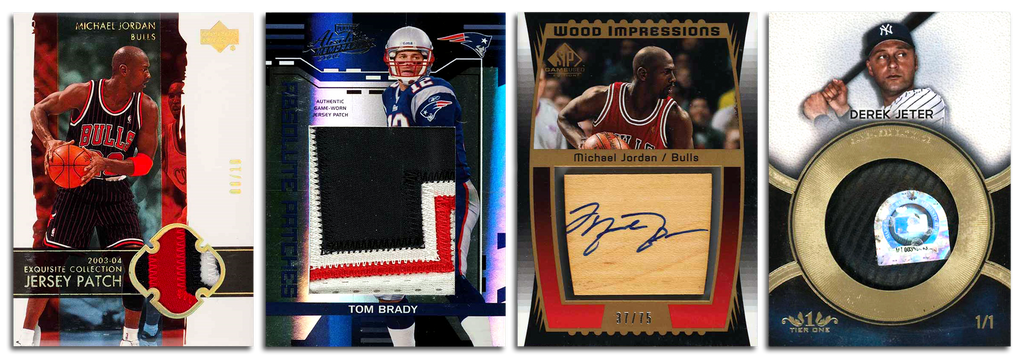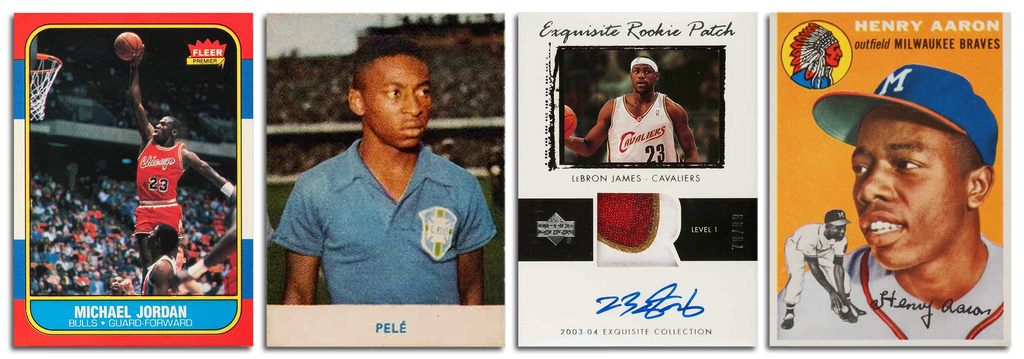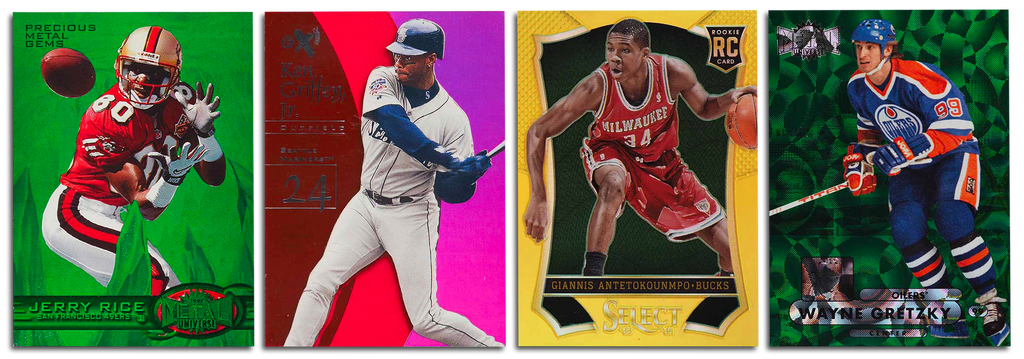A Comprehensive Guide to Sports Card Inserts
Sports card inserts are special cards that are included in packs of sports cards. They are typically rarer and more valuable than the base cards, and they often feature popular players or special designs. There are several different types of sports card inserts, each with its own unique characteristics. In this article, we will take a closer look at some of the most common types of sports card inserts.
Autograph Cards

- Sticker Autographs: This is the most common type of autograph found in the collector's market. These autographs are signed on stickers, which are then affixed to the cards. Sticker autographs are a staple in mass-produced card sets. They are easier to manufacture at scale since the player doesn't need to handle each individual card. However, because of their relative abundance, they usually don't hold as much value as other types.
- Cut Signatures: These cards are rare and often more valuable. A cut signature involves cutting out an autograph from a document or piece of fabric that has been signed by the player. This cut-out signature is then incorporated into a card. The uniqueness of this method and the often-historical context of the source document make cut signature cards a prized possession among collectors. Their rarity and the unique story behind each signature contribute to their higher value.
- On-Card Autographs: Regarded as the most desirable and authentic form of autograph cards, these are cards where the player has signed directly onto the card itself. The direct interaction of the player with the card adds a level of authenticity that is unmatched. On-card autographs are more challenging to produce, as they require the player to physically handle each card. This method is less susceptible to forgery and is highly valued in the collector's market. The rarity, combined with the direct connection to the player, makes these cards the most coveted among collectors.
Collectors often prefer autograph cards because they offer a tangible connection to the player. The signature on the card is a personal touch, making the card not just a collectible item but also a piece of sports history. The value of these cards can vary significantly based on the fame of the player, the rarity of the signature, and the condition of the card. As a result, autograph cards are not just a hobby but an investment for many collectors, with some cards appreciating significantly in value over time.
Game-used Cards

Game-used cards, a special category in sports memorabilia collecting, are distinguished by featuring actual pieces of memorabilia that were used in games. These cards are greatly valued by collectors for the unique and direct connection they offer to both the players and the sports they represent.
- Types and Varieties: Game-used cards can include a wide range of memorabilia pieces. Common examples are segments of game-worn jerseys, pieces of bats used in baseball games, chunks of basketball flooring, fragments of footballs, or even swatches of boxing gloves. Each type of memorabilia brings a different aspect of the game to the collector, offering varied experiences across different sports.
- The Collector's Appeal: What makes these cards so attractive to collectors is the physical piece of the sport's narrative they hold. Owning a game-used card is like owning a small part of a memorable game or a player's career. This connection is not just emotional but also historical, as each piece of memorabilia carries the story of its use in the game.
- Rarity and Value: The value of these cards is often influenced by factors such as the player's fame, the memorabilia's role in a significant game or event, and the overall rarity of the card. For example, a piece of a jersey worn during a championship game by a renowned player is likely to be more valuable than a standard game item.
- Investment and Legacy: Collecting game-used cards is often viewed not just as a hobby but as an investment. Certain cards, especially those linked to legendary players or iconic sports moments, can appreciate in value over time. They are not just purchased for personal enjoyment; they are also seen as a means to hold a share in sports history.
Game-used cards are a bridge between collectors and the sports they love, offering a tangible piece of the games and players that have shaped the sports world. Their appeal lies in their authenticity, historical significance, and the emotional connection they foster with fans and collectors alike.
Rookie Cards

Rookie cards hold a special place in the world of sports card collecting, as they represent the first official appearance of a player in a professional sports league. These cards are not just collectibles; they symbolize the beginning of an athlete's professional journey, capturing the moment when potential and talent first enter the wider public consciousness. Their appeal lies in the promise and possibility they represent - every rookie card could be that of a future superstar or hall of famer.
- Base Rookie Cards: These are the standard rookie cards, typically part of a set issued by card manufacturers. They feature the player in their professional team attire and often include basic information like name, team, and position. Base rookie cards are the most common type and serve as the entry point for many collectors into the world of rookie card collecting.
- Autograph Rookie Cards: These are rookie cards that have been personally signed by the player. The combination of a rookie card with the player's autograph adds an extra layer of value and uniqueness. Autograph rookie cards are highly sought after as they combine the potential of a new player with a personal touch.
- Game-Used Rookie Cards: These are rookie cards that incorporate a piece of memorabilia used by the player in their rookie season, such as a fragment of a jersey, bat, or other sports equipment. These cards offer a tangible connection to the player’s first professional season, adding a historical aspect to the card's appeal.
- RPA Cards: These are a premium type of sports card that combine the excitement of a rookie card with the authenticity of a game-used memorabilia piece and the personal touch of an autograph. Their rarity, combined with these features, makes them highly prized in the sports card collecting community, often representing the pinnacle of a collector's acquisition in the rookie card category.
- Value and Rarity: The value of rookie cards can vary greatly depending on the player's subsequent career success, the rarity of the card, and its condition. Cards of players who go on to have illustrious careers tend to be more valuable. Limited editions, special printings, or cards with errors can also be more valuable due to their rarity.
- Investment Potential: Rookie cards are often seen as an investment. A rookie card of a relatively unknown player can skyrocket in value if that player becomes a star. This speculative aspect makes collecting rookie cards exciting but also risky.
Rookie cards are a cornerstone of sports card collecting, offering a unique blend of potential, nostalgia, and a direct link to the early days of an athlete's professional career. They are treasured not just for their monetary value, but for their symbolic representation of the start of a player's journey in the world of professional sports.
Insert Cards

Insert cards in the world of sports card collecting are a fascinating aspect. These cards are intentionally included in packs as a bonus and are usually rarer and more valuable compared to regular or base cards. Here's a bit more detail about the different types of insert cards popular amongst collectors.
- Parallels: These are versions of base cards but with some variations. The variation could be in color, foil, or some other design element. Parallels are often produced in limited quantities, which adds to their rarity and value.
- Numbered Cards: As the name suggests, these cards are individually numbered. For example, a card might be marked as "25/100," indicating it's the 25th out of 100 identical cards. The lower the number, often the higher the value, especially if it's a popular player.
- Die-Cut Cards: These cards have unique shapes and designs, achieved through a die-cutting process. They might have rounded edges, intricate patterns cut into them, or other non-standard shapes. This distinctive feature makes them stand out and often increases their collectible value.
- Chase Cards: These are highly sought-after cards inserted into packs at a much lower rate than regular cards. They're called "chase" cards because collectors often have to "chase" them by buying many packs. They can feature unique designs, autographs, low serial numbers, or pieces of memorabilia like a swatch of a player's jersey.
- Promotional Cards: These are produced for a specific event or promotion. They might be distributed at a game, in a magazine, or through a special event. Their availability is usually limited to that event or promotion, making them rare once the event is over.
Collectors often seek these insert cards for their rarity, the popularity of the player featured, and the unique designs or features they offer. The thrill of finding an insert card in a pack can be a significant part of the appeal of collecting sports cards.
Conclusion
In conclusion, the world of sports card inserts offers a fascinating glimpse into the diverse and engaging aspects of sports memorabilia. These inserts, ranging from autograph cards, game-used cards, rookie cards, to various types of insert cards like parallels and die-cuts, each carry their own unique allure and value. Autograph cards, with their personal touch from players, provide fans with a direct connection to their heroes. Game-used cards offer a tangible piece of sports history, making the collector part of memorable games and moments. Rookie cards are prized for capturing the dawn of a player's career, holding potential for future greatness. Insert cards like parallels and numbered cards bring a rare and visually striking dimension to collecting.
Each type of insert caters to different aspects of a collector's passion, be it the thrill of finding a rare card, the joy of connecting a favorite player, or the excitement of owning a piece of sports history. These cards are more than just collectibles; they are a blend of investment, nostalgia, and a celebration of sports culture. The variety and depth of sports card inserts ensure that the hobby remains vibrant, diverse, and continuously appealing to collectors of all ages and interests. This dynamic facet of sports card collecting is not just about the value of the cards, but about the stories they tell and the memories they preserve, making them cherished pieces in any collection.
Protect your prized collection with our durable sports card carrying case. Shop now and find the perfect sports card cases to safeguard your investment!

Leave a comment